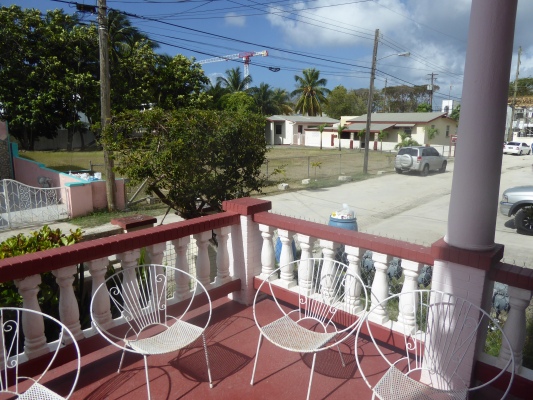 View fron the Veranda |
"Who is the boss in your household?" he asked Rex.
Meryl was sitting just a few hand slaps away, so Rex had to exercise supreme skills of diplomacy. I could almost hear him sucking the air in between his teeth as he considered his response. "Well ...., we work on a partnership basis," he replied, fortunately a sentiment echoed by Meryl, and I could see Rex visibly relaxing.
"But who is in charge of the money?" persisted Alex in his quiet voice.
"Well ....., we each have our own bank accounts which we access separately. But we trust each other to know that neither of us would go and waste a load of money on something unnecessary. We don't need to ask each other if we can spend our money," responded Rex. He fired back a question back to Alex, "Is it not the same in Barbados?"
"No," he replied. "In Barbados if a woman wants money for a new hair-do, she asks her husband. Or if they go out for a meal, the husband is expected to pay for everything. The woman never spends her own money." Hmmm..
"But in Barbados the women all work till they are 80," joked Rex. Alex smiled, and Meryl gave her other half a black look. I kept out of this conversation, it was going nowhere.
Alex then proceeded to tell us about the large two-storey construction that he was having built next door to his mother's house. His intention was to live in part of it, and rent out the rest. We learned from Alex that young folk in Barbados experience hard times getting onto the property ladder; not much different from Britain really. He was a plumber by trade, so was obviously completing all the plumbing tasks himself. Then it became apparent that he was attempting some of the electrical wiring tasks himself. He recently had hit an obstacle. The builders had concreted in a long length of conduit from a consumer unit downstairs, and he could not run a cable through it. I tried to ascertain what the problem was from the lad, but there seemed to be a communication barrier between us on this score. "Why don't we go across and you show me?" was my suggestion as to the only way to get to grips with this.
His face lit up, and soon Alex, Rex and me were walking amongst builder's rubble inspecting the consumer unit. The conduit was of course buried out of sight, all we could see was where it appeared into the consumer unit. A piece of metallic tape for pulling an electrical cable through, of the same rigidity and size as a car oil dipstick, was hanging out of the conduit. He demonstrated how, even using pliers to grip the metallic tape, he could not shift it further down the conduit. "So do you know how the conduit makes its way across to the end point?" I asked. He drew an imaginary horizontal line from the consumer unit, which turned vertically after 30cm and made for the ceiling, at which point it rotated to the horizontal and travelled 15m across the whole length of the building, and then shot up vertically to the upstairs. A quick climb upstairs, and a hole in the wall 1.5m up showed the end of the conduit. A water heater would eventually sit here.
I immediately saw the problem, and his efforts using the tape he was employing would be wasted. He had managed to push it around the first right angle bend, but he could not force it around the next. It took a while to convince him that his current approach would be fruitless. I then spent an even longer time explaining the concept of blown-fibre as used in the IT industry. Sadly, this was not Alex's field and he was either dumbfounded, or thought I was off my rocker; probably the latter. I asked him if he had a long length of string, perhaps I should have used the word cord since string was not in the Bajan vocabulary. 10 minutes later I had a roll of kite string in my hands. "We need to blow the string through, or suck it through the conduit," I explained. 5 minutes later we had a vacuum cleaner. Meanwhile, Rex was doing a sterling job in generating spreadsheets and PowerPoint presentations to manage the task in hand.
I arranged for Alex and Rex to hold the vacuum suction pipe to the conduit at the consumer unit end, while I fed the string down from upstairs. Within seconds I heard screams from downstairs. Large quantities of water and grit had been sucked out of the conduit, and the vacuum cleaner was frothing away. We sorted the cleaner out, and continued with our task. Some minutes later, Rex bounded upstairs to announce that the other end of the string had finally reached the consumer unit. Alex was amazed at this magic, and extremely grateful. I then explained he would have to use the thin string we had just fed through to draw through an even thicker piece of string, something thick enough to finally pull through the electrical cable. Now he understood, and we left him to it.
15 minutes later, we were ready to go off for the day. Alex collared me as we were about to leave, and took me back to the working end of the kite string. He now had his electrician with him, and they were about to haul through a long length of earthing cable instead of thicker string. "Just make sure you make a good join between the string and cable," I cautioned. As I turned to leave, he produced an immersion heater switch, and asked for advice on wiring it. I explained the concept of switched live and neutral, which side of the switch connected to the consumer unit, and which side to the heater, and left the two of them to it, thinking how on earth is the other chap an electrician?
 George Washington House |
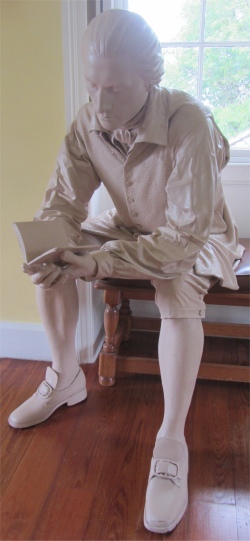 George Washington Reading from his Diary |
On 30th November 1966, the Garrison Historic Area was the location where the ceremony was held for the lowering of the Union Flag (the flag of the United Kingdom), and the raising of the Barbados flag, thus ushering in full independence for the country of Barbados from the United Kingdom.
In June 2011, The World Heritage Committee put a Heritage Stamp on the Historic Bridgetown and the Garrison areas. These sites were listed on the United Nations Educational, Scientific and Cultural Organisation's (UNESCO) World Heritage List. UNESCO's website is quoted as describing Historic Bridgetown and its Garrison as "an outstanding example of British colonial architecture consisting of a well-preserved old town built in the 17th, 18th and 19th centuries, which testifies to the spread of Great Britain's Atlantic colonial empire".
Rex had conveniently parked opposite the entrance to the George Washington House. We walked across to the ticket office, and a petite lady with short, fuzzy, grey hair greeted us with a big smile. Soon she was organising our tour around the site. "Go spend 10 minutes upstairs in the house on the self-guided tour first, then head up to the clock-tower for the changing of the guard. Do you want to visit the tunnels too?" she asked. We replied in the affirmative. "Come back after the changing of the guard, and then we can slot you into a tunnel tour and house tour," she advised, and one of her colleagues took us across to the self-guided tour at the top of the house.
The building, built around 1720, is the oldest "house" within the garrison, known today as the Bush Hill House or the George Washington House and Museum. It was acquired for the "New" Garrison in 1789, and was used primarily as the Resident Engineers Quarters. In the latter half of the 19th century it was known as the Bush Hill Commanding Officers Quarters. In 1906 the house returned to private ownership, and was used as a residence and later as offices. The Governor of Barbados acquired the property in 1999, after which it was restored as the George Washington House and Museum.
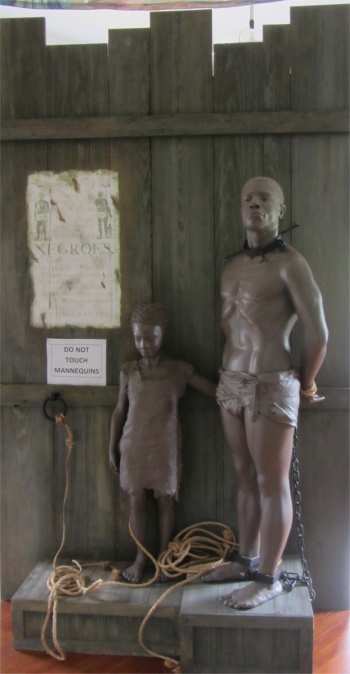 Depicting Slavery |
The upper floor of the building, where we found ourselves, is devoted entirely to displays of items typical of life in the mid-18th century, the items being richly described with both visual and audio aids. On display are some medical appliances of the time: pharmaceutical bottles, thumb lancets and cupping glasses which "were heated to create suction to draw blood to the skin's surface". An interesting display is a reminder that Washington contracted small pox, a deadly disease that was rampant at that time and quite frequently resulted in death to those who contracted it. Thus Washington was fortunate in the doctor who tended him and helped restore him to health. According to the record he was successfully treated by a Dr. Lanaham "a third-generation Barbadian" who was "a practitioner of physick and surgery", and the note adds the thought-provoking comment by historian Eustace Shilstone that "The course of the nation and perhaps of the whole world may have been changed if the doctor had been less skilful and attentive; a theme which needs no elaboration".
Other artefacts on display were reminders of the existence of slavery at the time Washington came to Barbados. On view are such things as spiked manacles, manacle and chain and barbed-neck collars "used as a form of restraint/punishment". Also displayed are agricultural implements such as a sickle, cane bill and hoe as well as other items found by archaeologists in digs close to George Washington House. These include stoneware, porcelain bowls, buttons, buckles, glass beads "probably used by slaves", pipe bowls, grape shot (cannon balls), gun flints, musket balls, bottle fragments and earthenware chamber pots. All these constitute a treasure trove helping to shed light on the Barbados which Washington visited.
Information on little known facts were brought out such as "in the context of the British Empire in the 17th and 18th centuries, Barbados played a surprisingly large and important role ... (and) was the central hub of the Caribbean for travellers and goods". It also had "one of the best fortified coast lines in the British Caribbean", something that proved of particular interest to George Washington who, with the approval of the Fort's Commander, examined these with great care. One report suggests that "the knowledge gained during his visits to the various forts along the west coast surely influenced his future military career". Washington was "an excellent horseman" and a "passionate landowner" too so it is of some importance that "What he observed for the first time in Barbados were some of the most innovative agricultural techniques of the day". These included "using dried cane stalks or bagasse as fuel in the boiling process', and "dung farming where animals were put into pens, fed grasses, brush or green matter to produce rich manure … to renew depleted soil in sugar cane fields".
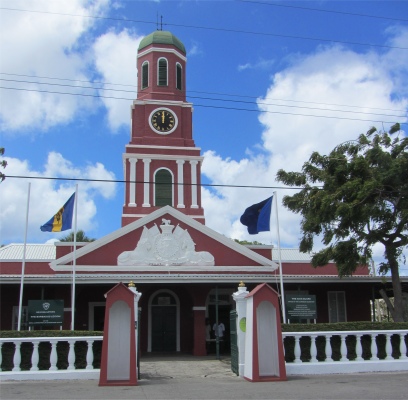 Main Guard |
After our allotted 10 minutes, we departed for the changing of the guard, skirting around the perimeter of the Savannah, to join a small group of folk patiently waiting for the ceremony to begin. A jeep drove up and a couple of fellows alighted in ceremonial attire and disappeared into the brick garrison building.
The building is the Main Guard, and overlooks the Savanna. It is one of the area's most outstanding buildings architecturally, and has a unique George III Coat of Arms, in Coade stone, which was designed especially for this building. In 1906, the Main Guard was bought locally and converted into the exclusive Savannah Club but is now owned by the Barbados Government and is the headquarters for organisations such as the Barbados Legion and Barbados Poppy League. It has a most imposing clock tower which chimes its way through the day helping those with no time-pieces of their own, people like me for instance. As with many of the other imposing garrison buildings, they are often built of London brick brought here as ballast, dating back to early days.
 Changing of the Guard |
 Tunnel |
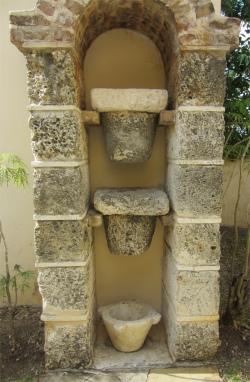 Dripstone |
Another commanding officer, this one sporting a handsome handlebar, greying moustache, extracted two blokes who had been marching at the back of the band via a shriek of commands, the new guards, and these were smartly marched up to face their counterparts who had only been on the scene for 10 minutes. Another barrage of barking and shrieking commands resulted in the old guards being replaced by the new. The band then marched off to a round of polite applause from the mainly British observers. A Scottish voice echoed from the depths of the Main Guard, "Thank you for the applause."
"That was the ceremony organiser speaking. He was in the Black Watch, took over this job for a while, and decided to stay," a short, stocky chap who was standing nearby informed us. "I'm staying just over there," he added, vaguely pointing to the east of the historic site. "This is my fifth visit to Barbados. Once you've been, you find you always want to come back. We've been to some of the other islands too, such as Antigua, which has a different beach for every day of the year, but there is much more to do on this island."
He was an electrician by trade, and now solely serviced marine electrics on craft in the Christchurch vicinity in Dorset. He waved us goodbye with a cheery smile as he set off for the rest of his day. We returned to the ticket office, where we were immediately put on a tour down the tunnels with another couple.
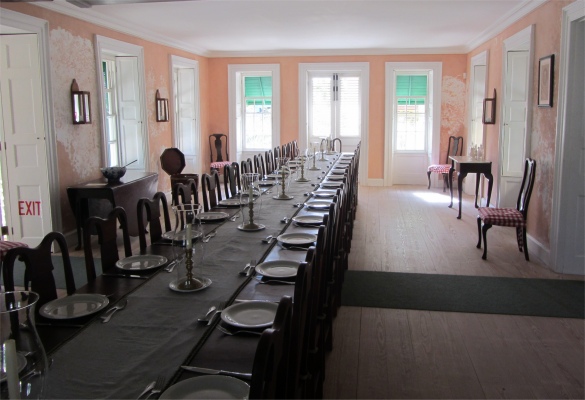 Dining Room in George Washington House |
The tunnel at George Washington House was "re-discovered" purely by chance, in June 2011, while preparation work was being undertaken, by the Garrison Consortium, for the relocation of the on-site cafe. After research and exploration, it was soon realised that this tunnel extended far beyond the boundaries of the property measuring approximately 3,200ft in length! So far it is estimated that the network is in excess of 10,000ft.
Our guide led us down concrete steps into a long, straight tunnel that started off 2m high, but the height was doubled by the time we had completed 216 feet. The tunnel had first been dug as a drainage trench, sinking into the coral bedrock. The top of the trench had been completed with ballast bricks, with three coping stones completing the arched roof. The tunnel we were in stretched 2Km on into the distance, the rest of it still needing more excavation, but this is where we emerged back out into the blinding sunlight.
After a quick lunch we were given a tour around the ground floor of the house, our bubbly guide ably describing the artefacts within the rooms, weaving a series of stories behind it all. She must have thought I was Scottish since she sang us a Scottish tune with a convincing lilt. She was most impressed that we correctly identified a candle snuffer and could explain why the two "holes" in the privy were so close to each other. Apparently every so often the public can book a meal around the huge dining table, with period costume available to add to the occasion.
 Bedrooms in George Washington House |
 Evening Meal at the Harlequin |
A small cinema in an adjacent building gave an excellent account of George Washington's history before he arrived on the island at the age of 19, and how he was changed by the visit.
We then mopped up the rest of the self-guided tour upstairs in the house. All in all, this historic site is very worthwhile a visit. We were now cultured out, and decided to leave the Barbados Museum on the Garrison Historic Area to another day.
We returned to our abode via a supermarket. Produce and services are a tad more expensive here than in the UK, but we learnt later that the value of sterling in the outside world had dropped dramatically.
In the evening, we caught a bus up to St. Lawrence Gap. Despite pressing bells, pulling cords and shouts, the driver obliviously overshot our desired drop-off point by 400m. Still, the walk did us good. Meryl plied me with a couple of rum punches in the same bar we had visited two nights earlier. They certainly hit the spot.
